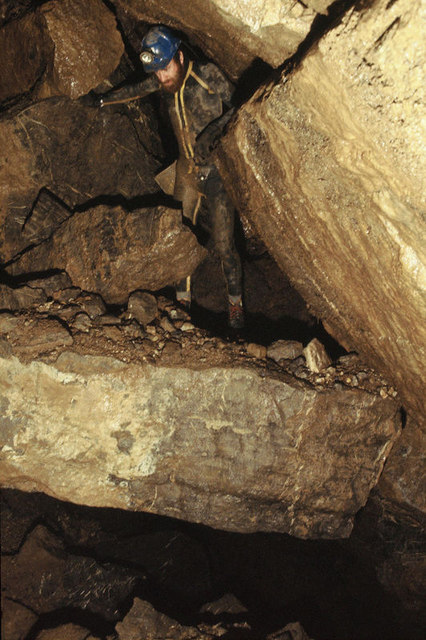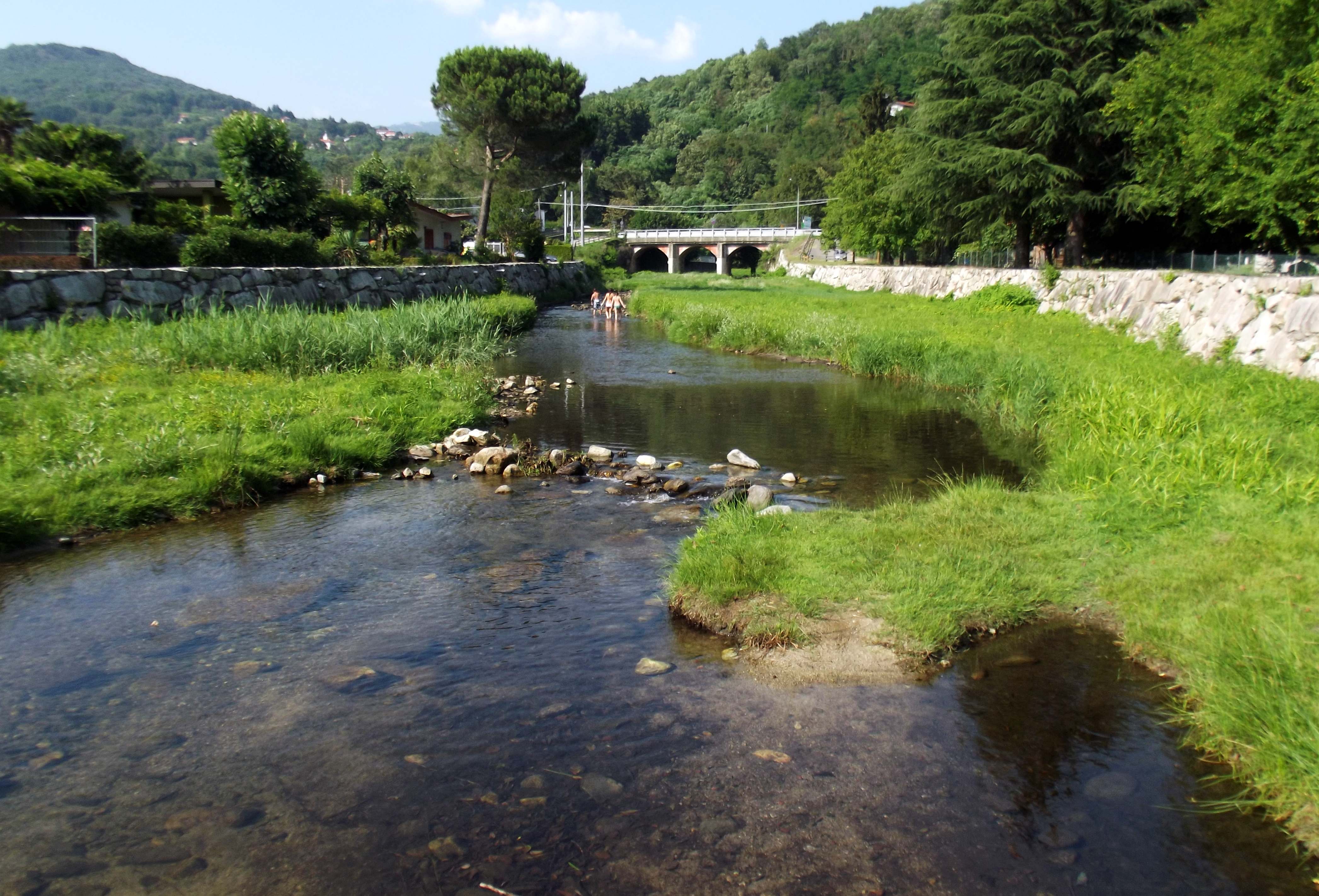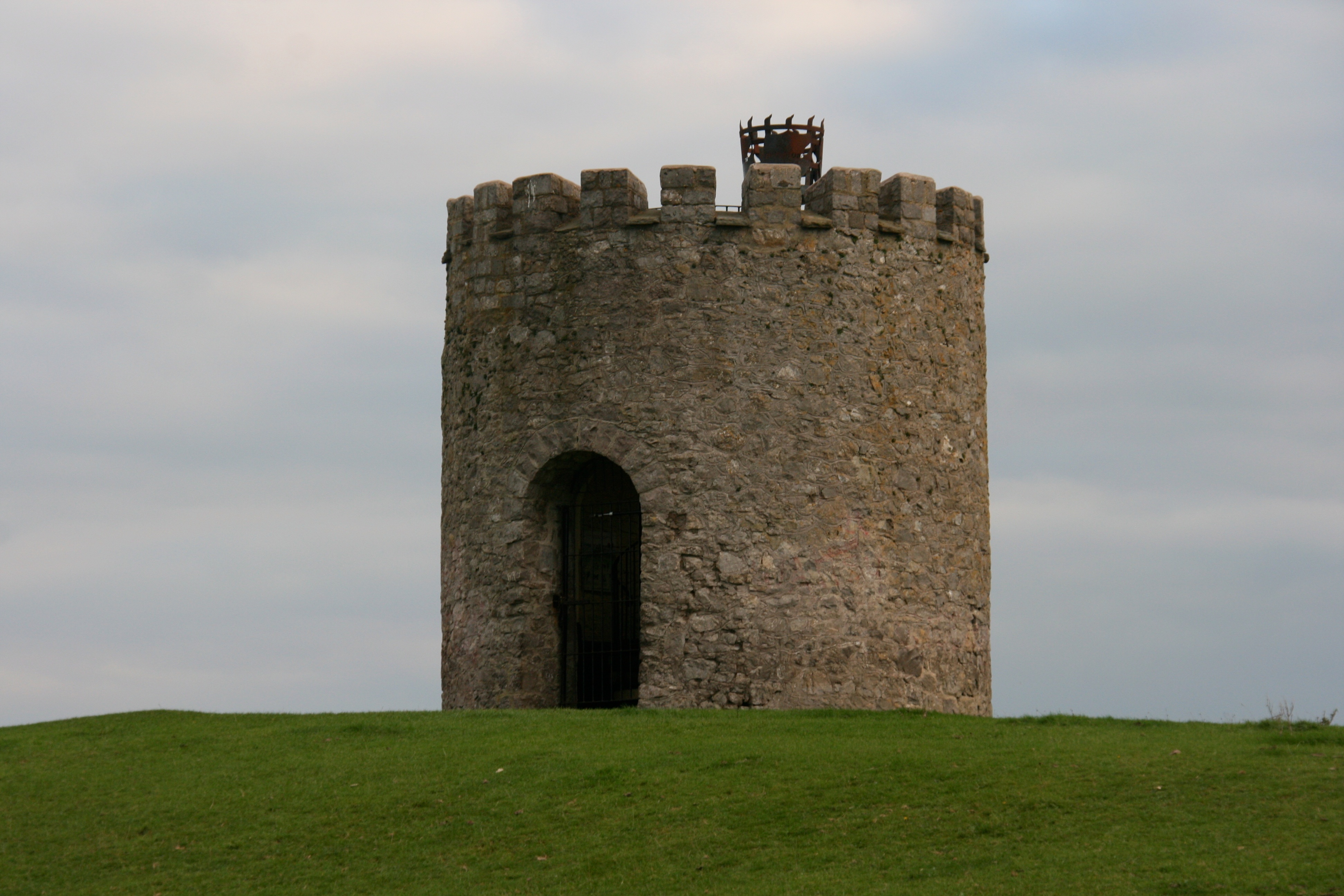|
River Axe (Bristol Channel)
The River Axe is a river in South West England. The river is formed by water entering swallets in the limestone and rises from the ground at Wookey Hole Caves in the Mendip Hills in Somerset, and runs through a V-shaped valley. The geology of the area is limestone and the water reaches Wookey Hole in a series of underground channels that have eroded through the soluble limestone. The river mouth is in Weston Bay on the Bristol Channel. The river was navigable from the middle ages until 1915, during early centuries of which seeing some European trade. Geography The River Axe is formed by the water entering the cave systems and flows through the third and first chambers, from which it flows to the resurgence, through two sumps and long, where it leaves the cave and enters the open air. It is the second largest resurgence on Mendip, with an estimated catchment area of , and an average discharge of per second. Some of the water is allogenic in origin i.e. drained off ... [...More Info...] [...Related Items...] OR: [Wikipedia] [Google] [Baidu] |
River Axe (Lyme Bay)
The River Axe is a long river in the counties of Dorset, Somerset and Devon, in the south-west of England. It rises in Dorset and flows south to Lyme Bay which it enters through the Axe Estuary in Devon. It is a shallow, non-navigable river, although its mouth at Seaton has some boating activity. The name ''Axe'' derives from a Common Brittonic word meaning "abounding in fish", and is cognate with '' pysg'' (a variant of '' pysgod''), the Welsh word for fish. The River Axe rises in several streams to the south of Chedington in Dorset, close the source of the River Parrett that flows north to the Bristol Channel. The Axe then flows west through Mosterton and Seaborough before turning south and forming the county boundary between Dorset and Somerset. In this section it flows past the villages of Wayford and Winsham, and the former Forde Abbey. At a point some north of Axminster Axminster is a market town and civil parish on the eastern border of the county of Devon in Engla ... [...More Info...] [...Related Items...] OR: [Wikipedia] [Google] [Baidu] |
Limestone
Limestone ( calcium carbonate ) is a type of carbonate sedimentary rock which is the main source of the material lime. It is composed mostly of the minerals calcite and aragonite, which are different crystal forms of . Limestone forms when these minerals precipitate out of water containing dissolved calcium. This can take place through both biological and nonbiological processes, though biological processes, such as the accumulation of corals and shells in the sea, have likely been more important for the last 540 million years. Limestone often contains fossils which provide scientists with information on ancient environments and on the evolution of life. About 20% to 25% of sedimentary rock is carbonate rock, and most of this is limestone. The remaining carbonate rock is mostly dolomite, a closely related rock, which contains a high percentage of the mineral dolomite, . ''Magnesian limestone'' is an obsolete and poorly-defined term used variously for dolomite, for limes ... [...More Info...] [...Related Items...] OR: [Wikipedia] [Google] [Baidu] |
Priddy
Priddy is a village in Somerset, England in the Mendip Hills, close to East Harptree and north-west of Wells. It is in the local government district of Mendip. The village lies in a small hollow near the summit of the Mendip range of hills, at an elevation of nearly above sea-level, and has evidence of occupation since neolithic times. There are remains of lead mining activities and caves in the limestone beneath the village. It is the venue for the annual Priddy Folk Festival. The Sheep Fair, was last held in 2013. Etymology Priddy, with medieval variations of spellings such as Predy, Priddie, Pridi, Pridia, Pridie and Prydde, is a name that has been ascribed to the Welsh influence that pre-dated the arrival of the Saxon English. It has been particularly attributed to pridd (= "earth"). This might be suggestive of the Iron Age mining activities. The Latin words pratum (= a meadow) and praedium (= a farm) have given rise to such Alpine names as Preda and Prada and it h ... [...More Info...] [...Related Items...] OR: [Wikipedia] [Google] [Baidu] |
St Cuthbert's Swallet
St Cuthbert's Swallet is the second longest, and most complex, cave on the Mendip Hills, in Somerset, England. It forms a major part of the Priddy Caves system and water entering this swallet re-emerges at Wookey Hole. – which also contains a detailed description of the cave. St Cuthbert's Swallet is part of, and lies underneath, the Priddy Pools Site of Special Scientific Interest. It is named because of its location in the St Cuthbert Out parish of Wells, and was originally called St Cuthbert's Pot. History Interest in the possible existence of a cave at this location existed before 1927, and increased when St Cuthbert's Pool suddenly drained away in that year. Attempts to discover an entrance took place between 1944 and 1953, when entry was finally gained. Exploration continued to push the known limits of the cave throughout the 1950s and 1960s. Sump 1 was passed in 1969. Sump 2 has not yet been passed. Access Due to a still enforceable court injunction dati ... [...More Info...] [...Related Items...] OR: [Wikipedia] [Google] [Baidu] |
Eastwater Cavern
Eastwater Cavern is a cave near Priddy in the limestone of the Mendip Hills, in Somerset, England. It is also known as Eastwater Swallet. It was first excavated in April 1902 by a team led by Herbert E. Balch composed of paid labourers and volunteers from the Wells Natural History Society. Progress was initially slow, but by February 1903 Balch and Willcox had discovered substantial passage, following the streamway down to the bottom of the cave. Dolphin Pot was dug in 1940 by the Wessex Cave Club, with Primrose Pot following in 1950. West End series was the most recent significant discovery, in 1983. On 28 August 1910 severe flooding rendered the boulder ruckles unstable, and the bottom of the cave was not reached again for another three years. The cavern was the site of a fatal accident in 1960, when Alan Hartnell was hit by rock-fall. Several areas of the boulder chokes remain unstable. Dolphin ladder pitch also suffered a rock fall and was blocked by a sofa-sized boul ... [...More Info...] [...Related Items...] OR: [Wikipedia] [Google] [Baidu] |
Swildon's Hole
Swildon's Hole is an extensive cave in Priddy, Somerset. At in length, it is the longest cave on the Mendip Hills. It has been found to be connected to Priddy Green Sink and forms part of the Priddy Caves Site of Special Scientific Interest (SSSI). The upper series of the cave compresses many features into a relatively short space. The cave goes far beyond this, however, and the lower reaches of the cave continue to provide challenges for even the most experienced of cave divers. The name may be a corruption of Swithun, an Anglo-Saxon bishop of Winchester, as the land in the area was owned by St Swithin's Priory in Winchester. History The cave was first entered on 16 August 1901 by members of the Wells Natural History and Archaeological Society. Very rapid progression was made to what is now known as the 40 foot pot. Between 1903 and 1910, in spite of access being banned by the landowner, various trips took place to photograph and explore the passages. In 1914 the limit ... [...More Info...] [...Related Items...] OR: [Wikipedia] [Google] [Baidu] |
Priddy Pools
Priddy Pools () is a geological Site of Special Scientific Interest at Priddy in the Mendip Hills, Somerset, notified in 1972. The pools provided the water supply for the Priddy Mineries which is now a Nature Reserve. Biological This site supports a very rich invertebrate and amphibian fauna. A wide range of seminatural habitats are present, including valley mire, open water, swamp and tall fen. These habitats have a restricted distribution in the Mendip Hills. Priddy Pools is situated in the central Mendip lead orefield and the ecology of the area bears the mark of the lead industry. The northern pool was dammed in the 1850s to provide a supply of running water for the sifting and washing of slag. Lead was processed at St Cuthbert's Works until 1908. The hydrology of the site is complex. Nutrient-poor water flows from springs in the north of the site to St Cuthbert's Swallet where it disappears before re-emerging at Wookey Hole. A valley mire has developed in the area ... [...More Info...] [...Related Items...] OR: [Wikipedia] [Google] [Baidu] |
Sinkhole
A sinkhole is a depression or hole in the ground caused by some form of collapse of the surface layer. The term is sometimes used to refer to doline, enclosed depressions that are locally also known as ''vrtače'' and shakeholes, and to openings where surface water enters into underground passages known as ''ponor'', swallow hole or swallet. A ''cenote'' is a type of sinkhole that exposes groundwater underneath. A ''sink'' or ''stream sink'' are more general terms for sites that drain surface water, possibly by infiltration into sediment or crumbled rock. Most sinkholes are caused by karst processes – the chemical dissolution of carbonate rocks, collapse or suffosion processes. Sinkholes are usually circular and vary in size from tens to hundreds of meters both in diameter and depth, and vary in form from soil-lined bowls to bedrock-edged chasms. Sinkholes may form gradually or suddenly, and are found worldwide. Formation Natural processes Sinkholes may capture surf ... [...More Info...] [...Related Items...] OR: [Wikipedia] [Google] [Baidu] |
Discharge (hydrology)
In hydrology, discharge is the volumetric flow rate of water that is transported through a given cross-sectional area. It includes any suspended solids (e.g. sediment), dissolved chemicals (e.g. CaCO3(aq)), or biologic material (e.g. diatoms) in addition to the water itself. Terms may vary between disciplines. For example, a fluvial hydrologist studying natural river systems may define discharge as streamflow, whereas an engineer operating a reservoir system may equate it with outflow, contrasted with inflow. Theory and calculation A discharge is a measure of the quantity of any fluid flow over unit time. The quantity may be either volume or mass. Thus the water discharge of a tap (faucet) can be measured with a measuring jug and a stopwatch. Here the discharge might be 1 litre per 15 seconds, equivalent to 67 ml/second or 4 litres/minute. This is an average measure. For measuring the discharge of a river we need a different method and the most common is the 'area-velocity' method. ... [...More Info...] [...Related Items...] OR: [Wikipedia] [Google] [Baidu] |
Drainage Basin
A drainage basin is an area of land where all flowing surface water converges to a single point, such as a river mouth, or flows into another body of water, such as a lake or ocean. A basin is separated from adjacent basins by a perimeter, the '' drainage divide'', made up of a succession of elevated features, such as ridges and hills. A basin may consist of smaller basins that merge at river confluences, forming a hierarchical pattern. Other terms for a drainage basin are catchment area, catchment basin, drainage area, river basin, water basin, and impluvium. In North America, they are commonly called a watershed, though in other English-speaking places, "watershed" is used only in its original sense, that of a drainage divide. In a closed drainage basin, or endorheic basin, the water converges to a single point inside the basin, known as a sink, which may be a permanent lake, a dry lake, or a point where surface water is lost underground. Drainage basins are similar ... [...More Info...] [...Related Items...] OR: [Wikipedia] [Google] [Baidu] |
Sump (cave)
A sump, or siphon, is a passage in a cave that is submerged under water. A sump may be static, with no inward or outward flow, or active, with continuous through-flow. Static sumps may also be connected underwater to active stream passage. When short in length, a sump may be called a duck, however this can also refer to a section or passage with some (minimal) airspace above the water. Depending on hydrological factors specific to a cave – such as the sea tide, changes in river flow, or the relationship with the local water table – sumps and ducks may fluctuate in water level and depth (and sometimes in length, due to the shape of adjacent passage). Exploration past a sump Diving Short sumps may be passed simply by holding one's breath while ducking through the submerged section (for example, Sump 1 in Swildon's Hole). This is known as "free diving" and can only be attempted if the sump is known to be short and not technically difficult (e.g. constricted or requiring nav ... [...More Info...] [...Related Items...] OR: [Wikipedia] [Google] [Baidu] |
Uphill River Axe
Uphill is a village in the civil parish of Weston-super-Mare in North Somerset, England, at the southern edge of the town, on the Bristol Channel coast. History Bone and stone tools found in caves at Uphill provide evidence of human activity in the Upper Palaeolithic period, and a radiocarbon date of around 28,000 Before Present, which came from a bone point, was the first scientifically derived direct date from the entire British Isles for an artefact of that period (the Aurignacian). The River Axe enters the Bristol Channel at Uphill where it is sheltered by Brean Down and it is possible that there was a port at Uphill in Roman times but no archaeological evidence has been found for this.Crockford-Hawley (2004) surmises that while ''archaeological evidence has yet to prove portexisted, most local people are quite happy to rely on long-established hearsay!'' Leach (2001) does not claim that there was a port at Uphill in the Romano-British period but does write that ''rivers ... [...More Info...] [...Related Items...] OR: [Wikipedia] [Google] [Baidu] |






.jpg)

